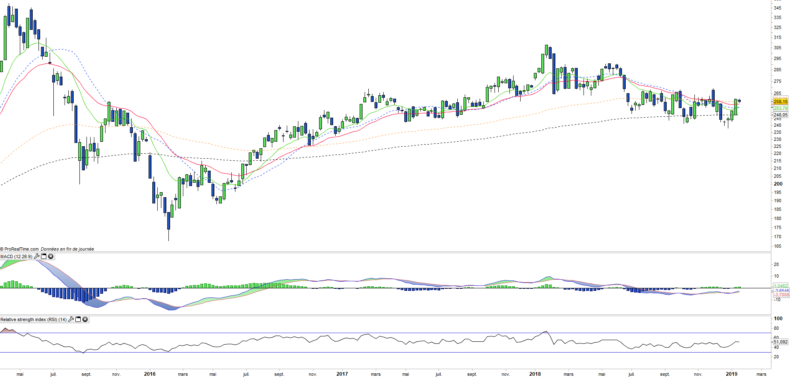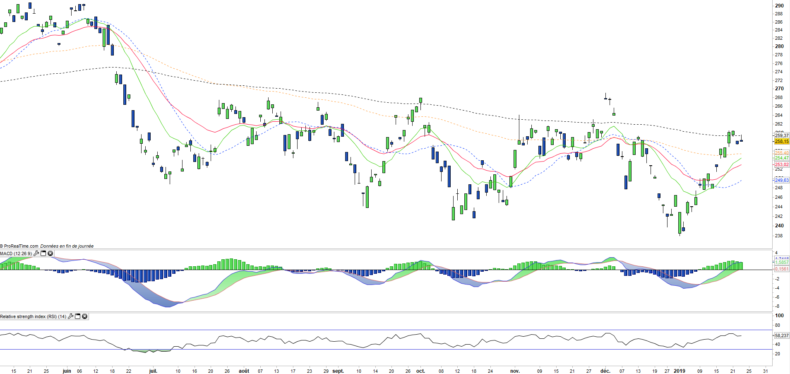Amundi ETF Chine (CC1) - 24/01/19
Short Term strategy: Positive (70%) / Trend +
Long Term strategy: Positive (60%) / Trend +
Characteristics of the ETF
The CC1 ETF (Amundi) created in 03/2009 is listed in EURO on Euronext and replicates the MSCI China-H net dividends reinvested index ("net return"), which is composed of the main Chinese stocks listed in Hong Kong and composed for 2/3 of financial values. These shares are subject to Chinese regulation but denominated in Hong Kong dollar (HKD). Chinese H shares, unlike A shares, are available to non-resident investors in China. The target for maximum tracking error between changes in the net asset value of the Fund and that of the MSCI China H Index is 2%. This tracker presents a currency risk linked to the exposure of the MSCI China H Index, resulting from the evolution of the reference currency, the Hong Kong dollar (HKD).
The fee of this ETF is 0.55% for an AUM of 118M €. The replication method is synthetic (via swaps).
Alternative ETFs: CSIA (Lyxor in Euro), FXI (iShares in USD)
Latest developments
After a rise of 13.6% in 2017, CC1 showed a decrease of -8.8% in 2018 which is mainly related to the credit restrictions decided by the Chinese authorities as well as to the commercial war between the US and France.
China, which became worse in the second half of the year with an accumulation of tariff increases on the part of the US administration. However the index resume 4.8% since the beginning of the year because of hopes of trade agreement, while the US and China have given themselves until March 1 to find an agreement. It is becoming important for China to bring down the pressure while macroeconomic statistics darken rapidly, with a car sector and consumption falling and investment declining.
New economic support measures may be needed to maintain a growth rate above 6% and social peace in the country.
Index & components
The equities that make up the MSCI China-H Index come from the universe of the most important stocks in the Chinese market.
The MSCI China-H Index is composed of 66 constituents, so it is relatively diversified. The financial sector (banks and insurance companies), however, accounts for about 68% of the capitalization while the China Construction Bank accounts for 16% of the index.
China is the world's second largest economy behind the US with a GDP of about $ 13600bn in 2017, the world's largest exporter with the world's largest foreign exchange reserves. The global recession of 2009 interrupted China's continued growth momentum, and the limits of its export-oriented growth model emerged. As a result of the global economic downturn and declining trade, Chinese growth decelerated to below 7% in 2015, its lowest level in 25 years. However, in 2017, growth reached 6.9% of GDP, an improvement over 2016 (6.7%).
State-owned enterprise debt accounts for 145% of GDP while private sector debt accounts for more than 200% of GDP. In addition, the quality of bank assets has deteriorated for several years and this trend is probably underestimated because of the importance of the shadow banking. Many challenges remain linked to the problem of an aging population, the lack of openness of the political system, the competitiveness of an economy dependent on high investment expenditure and the expansion of credit.
The manufacturing and construction sectors contribute nearly half of China's GDP, but the country is increasingly relying on services and domestic consumption. China has posted a 6.6% growth rate in 2018 and now expects growth between 6- 6.5% n 2019, which means a gradual soft landing linked to the new growth model, more based on quality, corresponding to an upscaling of industry and services, but also focused on reducing the current major imbalances (too high debt, overcapacity in industry and real estate).
China no longer seems to be in the race for growth, but in search of a more balanced and sustainable model based on the upscaling of its industry through technology and the expansion of services and domestic consumption. China faces geopolitical problems with most of its neighbors (India, Japan ...) and especially in the China Sea, because of its plans for territorial expansion that could lead to military confrontations. Its confrontation with the USA, at the commercial level, could be amplified under the background of the Korean crisis.
Weekly data
The analysis of the weekly charts shows a progressive reversal of the index, which however is not yet fully validated. Prices have returned above moving averages, but there is no real upward trend and prices are relatively flat. An upward momentum and the overrun of the € 268 zone are needed to bet on a new wave of rising that would lead to reach the peaks of 2018 again.
Daily data
The daily chart analysis shows that the short-term reversal is already well underway with the passing of the short term moving averages and the EMA100 and another attack in process of the EMA200 whose crossing is key to get a bullish acceleration. The EMA200 has been acting as a resistance since September 2018, and its overtaking confirmed over several sessions would be a strong signal.
Theme
CC1 is a UCITS ETF, listed in EUR, which seeks to replicate the MSCI China H index
Characteristics
| Inception date | 03/03/2009 |
| Expense ratio | 0,55% |
| Issuer | Amundi |
| Benchmark |
MSCI China H
|
| Code/Ticker | CC1 |
| ISIN | FR0010713784 |
| UCITS | Yes |
| EU-SD Status | Out of scope |
| Currency | Euro |
| Exchange | Euronext Paris |
| Assets Under Management | 118 M€ |
| PEA (France) | Yes |
| SRD (France) | Yes |
| Currency Risk | Yes |
| Number of Holdings | 68 |
| Risk | 4/5 |
Country Breakdown
| China | 100% |
Sector Breakdown
| Financials | 66% |
| Energy | 10% |
| Industrials | 7% |
| Materials | 4% |
| Consumer Discretionary | 3% |
| Communication Services | 3% |
| Health Care | 2% |
| Others | 5% |
Top Ten Holdings
| China Construct Bank | 17% |
| ICBC | 10% |
| Ping an Assurance | 10% |
| Bank of China | 7% |
| China Petroleum Chem | 4% |
| Petrochina Co | 3% |
| China Life Insurance | 3% |
| Agricult BK China | 3% |
| China Merchants Bk | 3% |
| China Pacific Insur | 2% |


